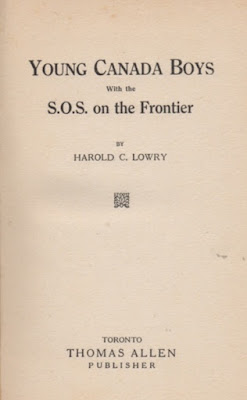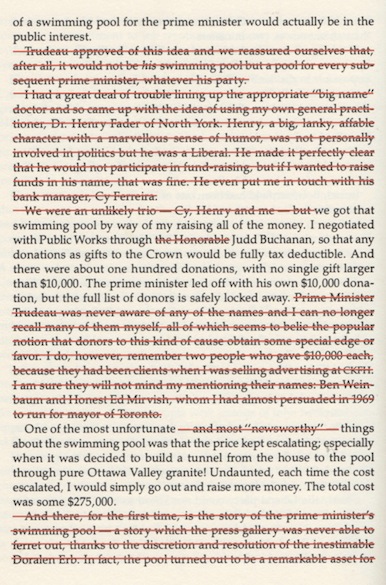Young Canada Boys with the S.O.S. on the Frontier
Harold C. Lowry [sic]
Toronto: Thomas Allen, 1918
A boys' adventure story from the Great War, doesn't this look like a series title? Could've been, I suppose, had the Armistice not been signed the month after publication.
Lowrey's "Young Canada Boys" are the "Scouts of the Allies' Patrol", a Baden-Powell-inspired group whose members more or less represent the Allied Powers. "Cod" Martin was born in Newfoundland. "Cinders" Thomas's father is a Welshman, "Marne" Armand's veins flow with French blood and "Rusty" Kelly will never deny he's Irish, "even though he hated the mention of the evil word [sic] 'Sein Fein.'" Twelve in number, they're a pretty tight group, though "Jap" Douglas, whose missionary parents proselytized in the Orient, is repeatedly accused of being "yellow".
All of 'em – well, maybe not Jap – are itching "to give the Huns such a corking good lickin' they'll never want another war as long as the world lasts." But because they're too young, the scouts do the next best thing by enlisting as Soldiers of the Soil.
Scouts of the Allies' Patrol existed only in Lowrey's imagination, but Soldiers of the Soil – the S.O.S. of the title – was very much real. Formed in the final year of the war, it sought to fill the labour shortage on Canadian farms with strapping young lads like Cod, Cinders, Marne, Rusty and… okay, we'll take Jap.
Young Canada Boys with the S.O.S. on the Frontier was intended as a work of propaganda, and Harold C. Lowrey was just the man for the job.
 |
| Canadian Grocer, 31 January 1913 |
Dumb luck leads the scouts to stumble upon instructions left behind by the clumsiest German spies found in fiction. They share the evidence with the commanding officer of nearby Niagara Camp (read: Camp Niagara), who promptly hands the group over to dashing Chief Intelligence Officer Major Watson. The scouts are smitten – the mere sight of the man sets "Anzac" Woodruff's "lithe young body a'throb with excitement" – but I wasn't so affected. To be perfectly frank, I found the Major himself a bit of a suspicious character. Consider this: Niagara Camp has fourteen thousand men, but Watson sets out to catch the enemy accompanied only by the boys and an underling named Lewis. Lowrey's explanation only fuelled my suspicions: "he could not resist smiling at the eager looks on the faces of the scouts. Anzac's keen eagerness quickly caught the officer's fancy and approval; he was a boy after his own heart."
My fears were unfounded. The climax, such as it is, involves slingshots, revolvers, falling boulders and a pit of thirty-eight seventeen-foot rattlesnakes that crush the life out of two men.
Seventeen-foot rattlesnakes? The whole thing, fantastic and incongruous, was hard to take seriously.
Black knot, on the other hand…
Bloomer? Bloomers?:
"Catch a spy ? Why say, kid, you couldn't catch a spiced pussy, let alone a German spy," laughingly asserted Chuck, giving Anzac the spanking he deserved. A lively tussle followed, which all the patrol enjoyed immensely.Object: A bland hardcover, 202 pages in length, the most interesting thing about it is the misspelling of the author's name on the title page.
Shades of News Stand Library.
Access: Two copes are right now listed for sale online, neither of which is in great shape. At US$25.00, the cheaper is falling apart and is splattered with white paint. The other copy is just about as bad, though it does bear the author's signature. It's yours for US$55.00. I bought mine earlier this year for one Canadian dollar at a thrift store not four blocks from my home.
Young Canada Boys with the S.O.S, on the Frontier can be found at the Toronto Public Library and seven of our universities. It can be read online here at the Internet Archive.
I wouldn't recommend it.
Related post:


























































